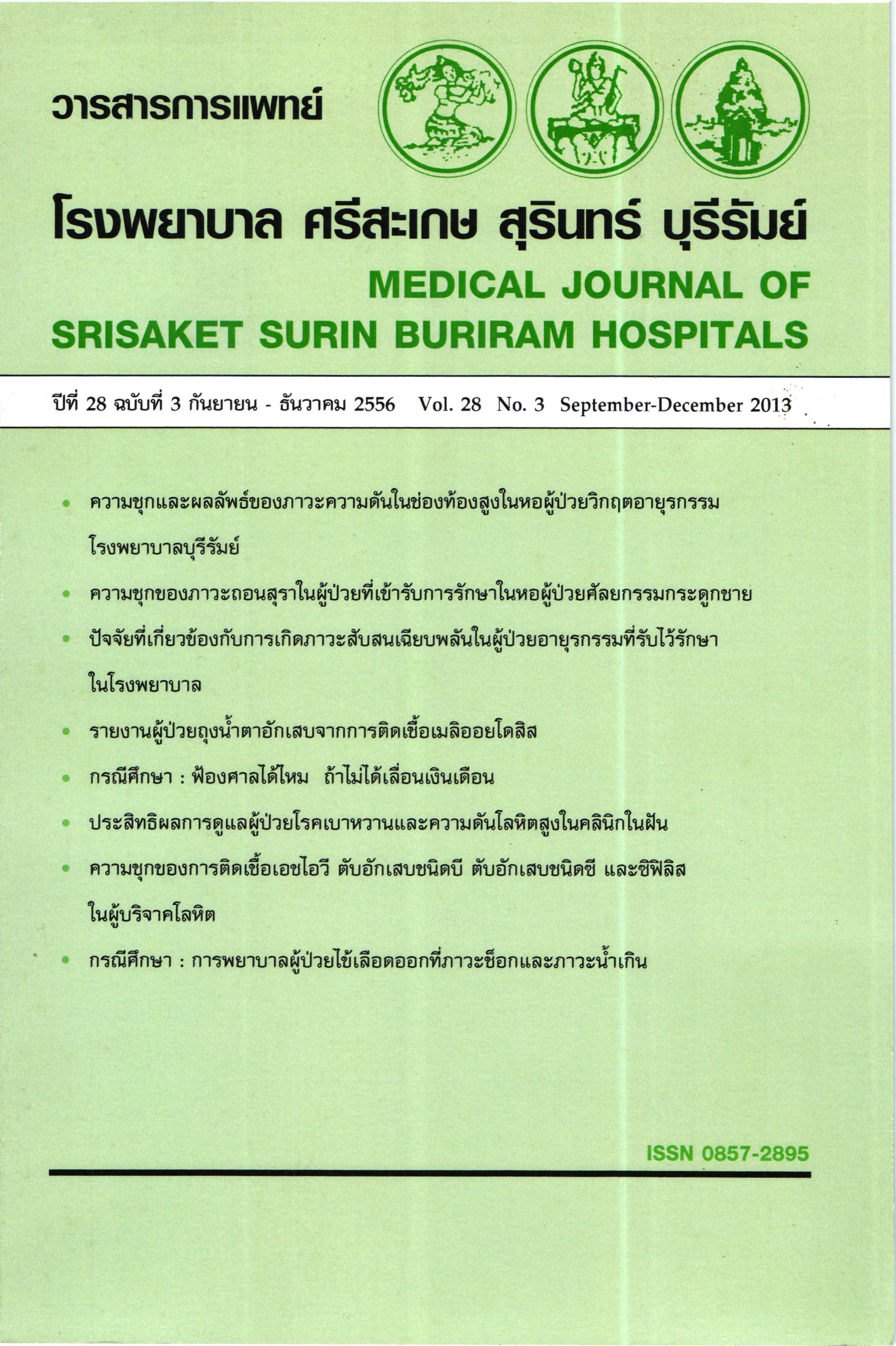ความซุกและผลลัพธ์ของภาวะความดันในซ่องท้องสูงในหอผู้ป่วยวิกฤตอายุรกรรม โรงพยาบาลบุรีรัมย์
Main Article Content
บทคัดย่อ
หลักการและเหตุผล: ภาวะความดันในซ่องท้องสูง พบได้บ่อยถึงร้อยละ 20-80 ในผู้ป่วยวิกฤต การวินิจฉัย ทำได้โดยการวัดความดันในซ่องท้องผ่านทางสายสวนปัสสาวะ ภาวะนี้ยังมีผลกระทบ ต่อระบบอวัยวะต่างๆ รวมทั้งระยะเวลาการอยู่โรงพยาบาล การตระหนักถึงการวินิจฉัย และความสำคัญของภาวะนี้ในผู้ป่วยหนักในโรงพยาบาลจึงมากขึ้นในปัจจุบัน
วัตถุประสงค์: เพื่อศึกษาความซุกของการเกิดภาวะความดันซ่องท้องสูง ในผู้ป่วยที่เข้ารับการรักษา ในหอผู้ป่วยวิกฤตอายุรกรรม ปัจจัยเสี่ยงและผลของภาวะความดันซ่องท้องสูงที่มีต่อ ระบบตาง ๆของร่างกาย จำนวนวันนอนโรงพยาบาลและอัตราการตาย
รูปแบบการวิจัย: การศึกษาแบบไปข้างหน้าในช่วงระยะเวลา 1 ปี ตั้งแต่ มิถุนายน พ.ศ. 2555 ถึง มิถุนายน พ.ศ. 2556 ในผู้ป่วยผู้!หญ่ที่เข้ารับการรักษาในหอผู้ป่วยวิกฤตอายุรกรรม มากกว่า 24 ชั่วโมงและมการใส่เครื่องช่วยหายใจและสายสวนปัสสาวะอยู่แล้ว ได้ทำการวัดความดันในช่องท้องโดยวิธีการวัดวันละ 1 ครั้งตอนเข้าเป็นเวลา 3 วัน เก็บข้อมูลพื้นฐานของผู้ป่วย ปัจจัยเสี่ยงและการรักษาที่ได้รับ ติดตามผลของ การรักษาและอัตราการตายจนจำหน่ายออกจากหอผู้ป่วยวิกฤต
ผลการศึกษา: ผู้ป่วยทั้งหมด 66 ราย เพศขาย ร้อยละ 57 อายุเฉลี่ย 62.4ปี ความซุกของภาวะความดันในช่องท้องสูงเป็นร้อยละ 33.3 ค่าเฉลี่ยความดันในช่องท้องคือ 10.7 มม.ปรอท โดยผู้ป่วยร้อยละ 66.7 พบภาวะนี้ตั้งแต่สองวันแรกหลังรักษา โดยปัจจัยเลี่ยงคือ ระบบแข็งตัวของเลือดผิดปกติ, ภาวะเลือดเป็นกรด, ภาวะตับแข็งและนํ้าในช่องท้อง, ภาวะการติดเชื้อในกระแสโลหิต เป็นปัจจัยเลี่ยงที่สำคัญ (Relative risk RR 2.09, 1.82, 1.76, 1.63 ตามลำดับ) และการมีปัจจัยเลี่ยงตั้งแต่ 4 ข้อชื้นไปสัมพันธ์กับระบบ อวัยวะล้มเหลว ภาวะติดเชื้อในกระแสเลือด และผู้ป่วยที่มีภาวะความดันในช่องท้องสูง พบว่า คะแนน sequential organ failure assessment (SOFA)tนที 1 และ 3, คะแนน acute physiology and chronic health evaluation, version II score (APACHEII),simplified acute physiology score, version II (SAPII), lactate, creatininettละปริมาณสารนี้าทั้งหมดที่ได้รับสูงกว่ากลุ่มควบคุมแต่ค่า central venous oxygen (SCV02), base excess, ปรมาณปัสสาวะตํ่ากว่า อัตราการนอน โรงพยาบาล อัตราตายและอัตราการใช้เครื่องช่วยหายใจในผู้ป่วยที่มีภาวะนี้สูงกว่า อย่างมีนัยสำคัญทางสถิติ
สรุป: ภาวะความดันช่องท้องสูงพบได้บ่อยในผู้ป่วยวิกฤตอายุรกรรม สัมพันธ์การเกิดอวัยวะล้มเหลวหลายระบบโดยเฉพาะระบบหายใจและไต ทำให้จำนวนวันนอนโรงพยาบาล และอัตราตายสูงชื้น
Article Details
เอกสารอ้างอิง
2. Malbrain ML, De laet I, Cheatham M. Consensus conference definitions and recommendations on intra-abdominal hypertension (IAH) and the abdominal compartment syndrome (ACS) the long road to the final publications, how did we get there?. Acta Clin Belg Suppl 2007;62:44-59.
3. Malbrain ML, Cheatham ML, Kirkpatrick A, Sugrue M, De Waele J, IvaturyR. Abdominal compartment syndrome: it’s time topay attention! Intensive. Care Med 2006;32:1912-4.
4. Malbrain M, Jones F. Intra-abdominal pressure measurement techniques. In: Ivatury R,Cheatham M, Malbrain M, Sugrue M, editors. Abdominal compartment syndrome.Georgetown(TX): Landes Bioscience; 2006: p. 19-68.
5. Sanchez NC, Tenofsky PL, Dort JM, Shen LY, Helmer SD, Smith RS. What is normal intra-abdominal pressure? Am Surg 2001;67:243-8.
6. Davis PJ, Koottayi S, Taylor A, Butt WW. Comparison of indirect methods of measuring intra-abdominal pressure inchildren. Intensive Care Med 2005;31:471-5.
7. De Waele J, Pletinckx P, Blot S, Hoste E.Saline volume in transvesical intra-abdominal pressure measurement: enough is enough. Intensive Care Med 2006;32:455-9.
8. Malbrain ML, Deeren DH. Effect of bladder volume on measured intravesical pressure: a prospectivecohort study. Crit Care 2006;10:R98.
9. Malbrain ML, Chiumello D, Pelosi P, Bihari D, Innes R, Ranieri VM, et al. Incidence and prognosis of intra-abdominal hypertension ina mixed population of critically ill patients: a multiple-center epidemiological study. Crit Care Med 2005;33:315-22.
10. Malbrain ML, Chiumello D, Pelosi P, Wilmer A, Brienza N, Malcangi V, et al. Prevalence of intra-abdominal hypertension in critically ill patients: a multicentre epidemiological study. Intensive Care Med 2004;30:822-9.
11. Cheatham ML, Malbrain ML, Kirkpatrick A, Sugrue M, Parr M, De Waele J, et al. Results from the International Conference of experts on intra-abdominal hypertension and abdominal compartment syndrome. II. Recommendation Intensive Care Med 2007;33:951-62.
12. Malbrain ML, De laet IE. Intra-Abdominal Hypertension : Evolving Concepts. Clin Chest Med 2009; 30:45-70.
13. Cheatham ML, Safcsak K. Is the evolving management of intra-abdominal hypertension and abdominal compartment syndrome improving survival. Crit Care Med 2010;38:402-7.


